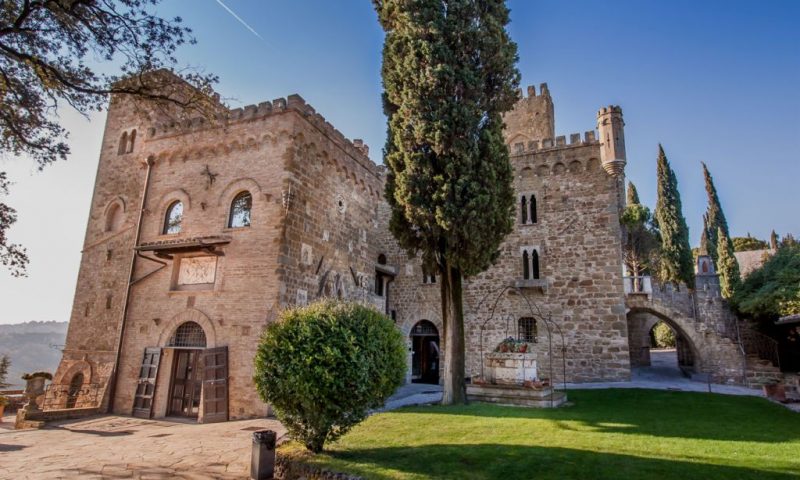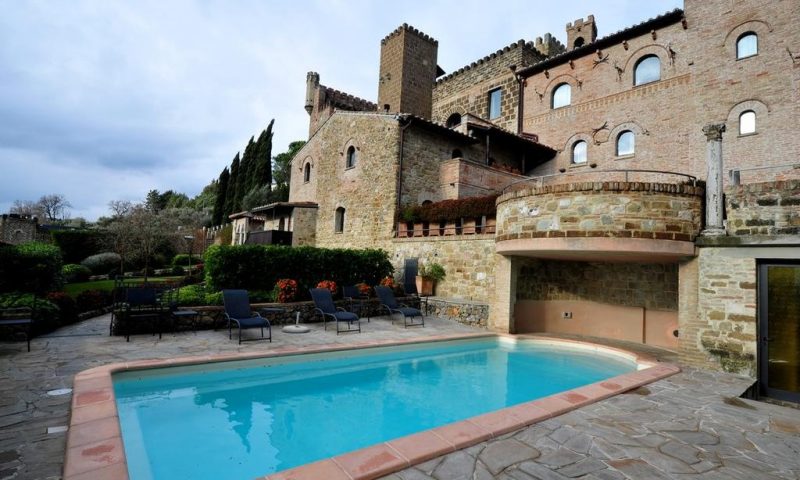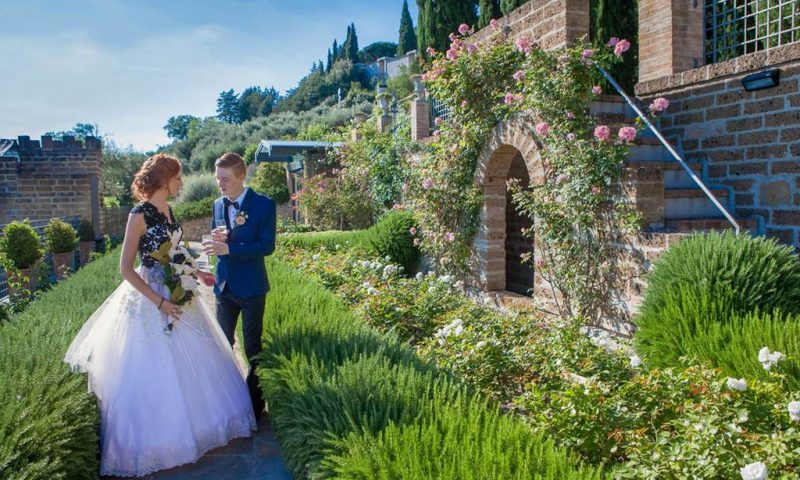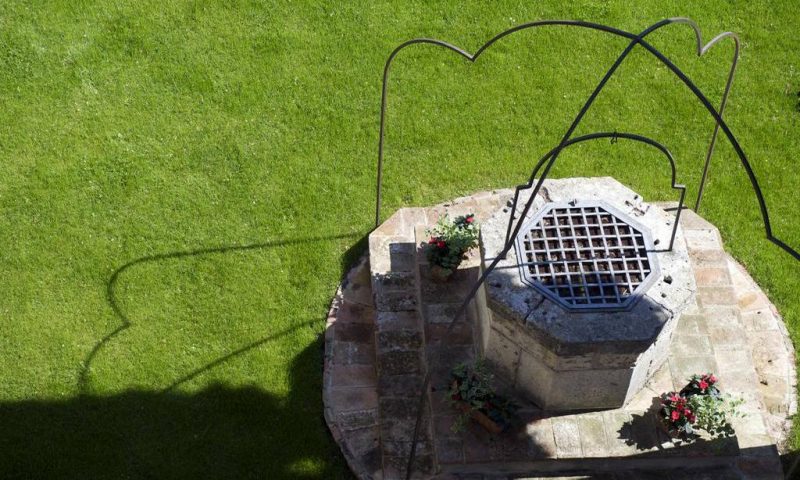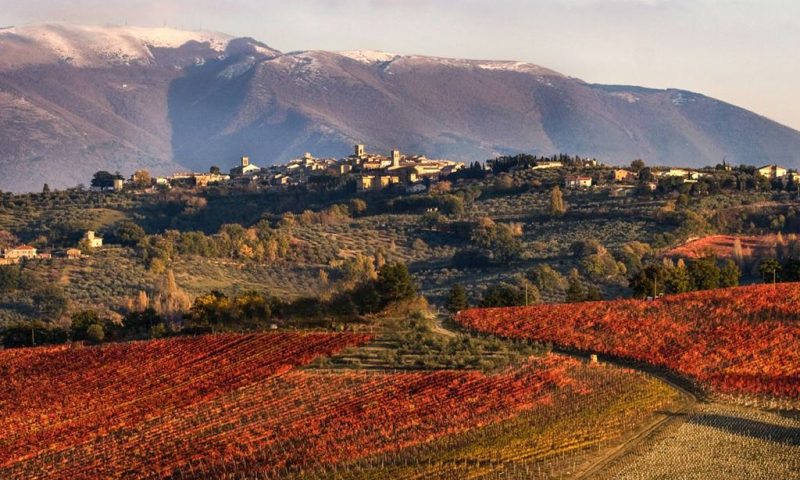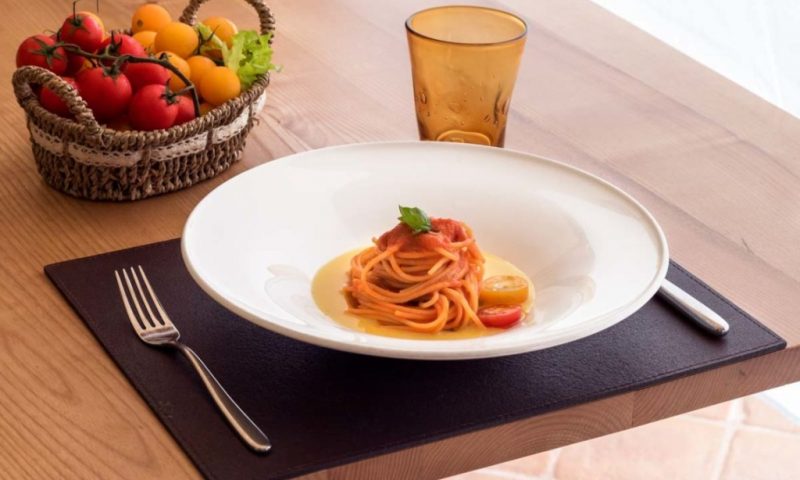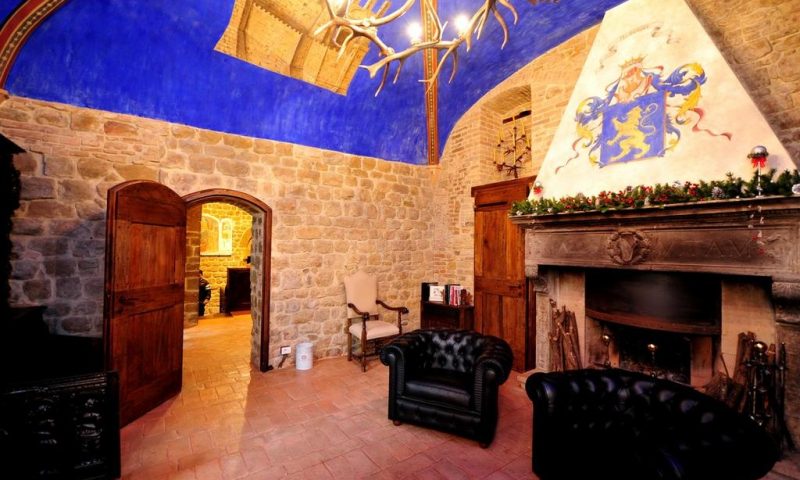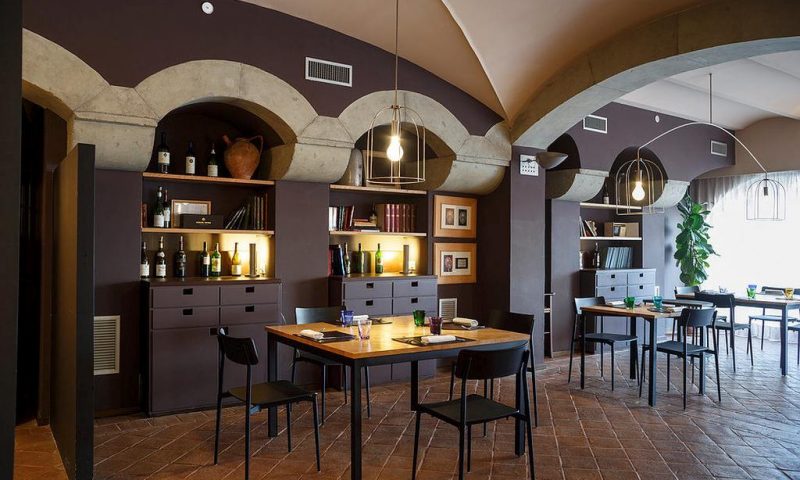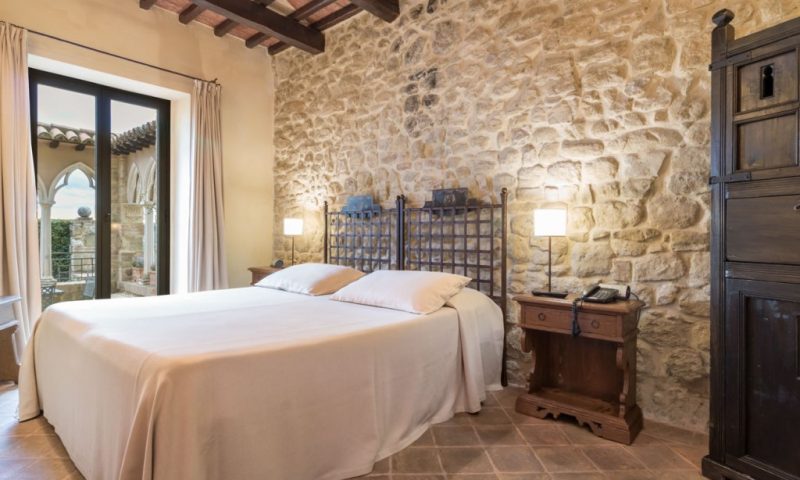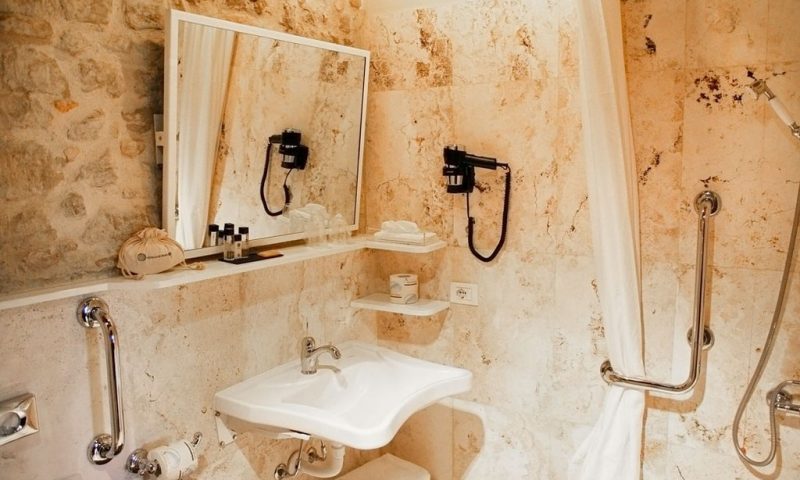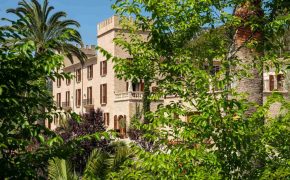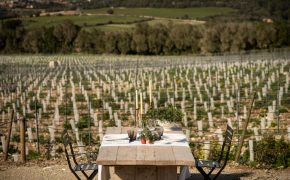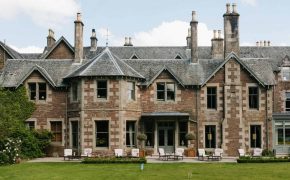When you look out from the terraces, which offer a unique view of Perugia and its valley, you will realize how rich is the history of this land and how little life has changed in this corner of Italy over the centuries.
For us, the Monterone Castle was a love at first sight. A love for its history and for the history of our land, shaped by the lives of great artists, saints, conquerors and poets. We wanted to preserve this history and invite all of you to discover it, to become part of it.
This ambitious project has led us to transform the castle into a beautiful and unique hotel in the heart of Umbria. The Castle is a short walk from the historic center of Perugia, along the road leading to Assisi.
THE HISTORY
The history of this castle, passed through the centuries, date back at least the eleventh century. An indication of a building in the locality Monterone is already in a document dated 18th January 1200, preserved in the Archives of State in Perugia.
In addition, there is a long tradition, deeply rooted among scholars, of a Templar belonging of this building, located, not surprisingly, a few hundred meters from the Templar church of St. Bevignate.
In the fifteenth and sixteenth centuries, the Castle was badly damaged during the civil war between the noble families of Perugia. The first renovations of the castle were carried out in 1849.
The inauguration took place in the same year, at the presence of Gioacchino Pecci, Archbishop of Perugia and future Pope with the name of Leo XIII. The current appearance of the castle is due to the final enlargement of 1886, followed by other operations of minor importance in the fifties and sixties of the twentieth century.
ROOMS & SUITES
Every room tells a story: Dell’Etrusco room, whose name comes from a little face of etruscan origin, set in the walls of the bathroom; La Segreta, a room discovered in 2005, during the restoration works; Del Drago – probably the room of the ghost… – that dues his name to a stone tile depicting a dragon.
Each room contains antiques and they have the comfort of a modern hotel, but keeping the medieval style: furniture and beds are made by specialised artisans of wood and iron.
CAMERA DEL CARDINALE
Deluxe Room with internal bath (through stairs, 1st floor). Plastered walls with geometrical pieces of frescoes. Panoramic view on the countryside. Bathroom with jacuzzi bath. Next to the room La Segreta.
CAMERA DELLE CHIAVI
This room due his name to a stone depicting two keys and a mysterious date: 15 january 1516. Next to the room L’Angiolo, it has a small private space and it is situated in the court of the castle, above the pool area and it faces on the countryside.
CAMERA DELLE DAME
Thanks to ten windows all along the perimeter of the room, the guest of this room will admire a spectacular and wide view on the valley under Perugia and on the gardens of the castle. The lightness of the room and the frescoes that completely cover its internal walls make this room one of the most attractive of the castle.
GRADALE RESTAURANT
The simplicity of homemade pasta, of fresh and genuine vegetables, of the extravirgin oils made in the surrounding lands, are the basis of our cooking proposal.
Settled in the cozy dining room or on the covered terrace, overlooking the Umbrian countryside, you can taste the gastronomic experience designed by our chef.
RELAX & WELLNESS
At Monterone Castle you can experience a full relaxing experience: welcomed in elegant spaces of the old house or walking among the roses in the beautiful rose garden, it will be easy to lose yourself in a timeless peace, finding serenity and harmony away from everyday stress.
THE ROSE GARDEN
In the ancient medieval castles it was customary to allocate a quiet and sheltered wing of the garden just for the ladies. Our rose garden was created as a tribute to the women of the castle. With its 250 rose plants, from 20 varieties, it will take you on a true immersion into the floral beauty, enriched by a wonderful panorama of Perugia.
RELAX AREA
At Castello di Monterone you will find a small relaxation area with an outdoor (unheated) outdoor pool, sauna and steam room. These services are made available free of charge for our guests: a little attention to brighten up your stay.
WEDDING IN UMBRIA
Elegant setting, attention to detail and an excellent restaurant, make the Castello di Monterone the ideal place for an exclusive and unforgettable wedding in one of the most beautiful places in Umbria. Reserve the whole hotel and you will live your wedding day as the prince and the princess of a real Italian castle.
MEETING ROOM
Castello di Monterone is the perfect place for meetings, conferences and presentations. The “Piceller” meeting room can accommodate up to 100 people and it is fully equipped with he most up-to-date technological equipment. The Gradale restaurant is available to organize coffee breaks, buffets and dinners tailored to the needs of your guests.
The Piceller meeting room is modern and equipped with all amenities, ideal for meetings, workshops, professional trainings, training courses and conferences.
Are you planning to launch a new product? Do you want to propose a new service to your customers? Your business presentations deserve a dramatic location! Impress your guests by inviting them to Castello di Monterone.
The halls and the outdoor spaces of Castello di Monterone can be set up to host team building activities. An ideal location, surrounded by greenery and easily reachable from Rome and Florence.
DISCOVERING UMBRIA
“Umbria is a noble land that is, at its core, also the salt of the earth. […] the misty vistas of the central Apennines, the fresh-from-the-farm cooking and the comforting intimacy of Italian culture would become my benchmarks for judging the quality of life everywhere else. One of the magical qualities of Umbria is that this is a place where a casual dinner can still feel like a life-altering experience.” (The Washington Post)
PERUGIA
Visit Perugia and discover the old town, the museums, the Etruscan and medieval monuments and enjoy the city life.
PERUGIA’S OLD TOWN
The Old Town of Perugia is built around the Fontana Maggiore and grows in a long series of ups and downs, roads and streets, alleys and stairways, underground routes, unusual and picturesque views of beautiful landscapes. Numerous and impressive are the Etruscan monuments: the Etruscan Arch, the Etruscan Well and the ancient Etruscan walls (3 km long).
During the medieval period, Perugia has experienced a period of great wealth and ambition that has led it to enrich the Old Town area with splendid monuments: the Fontana Maggiore, the Aqueduct, the Sala dei Notari, Palazzo dei Priori, the Rocca Paolina (where the old medieval streets of Perugia are kept unchanged) and many others.
Perugia has an Old Town that must be discovered step by step, with no hurry, being fascinated by the history and the beautiful works of art scattered over these hills at the centre of Umbria.
THE NATIONAL GALLERY OF UMBRIA
The National Gallery of Umbria is located in Palazzo dei Priori and preserves the largest collection of Umbrian art from the thirteenth to the nineteenth century: in it are exhibited works by Arnolfo di Cambio, Duccio, Gentile da Fabriano, Benozzo Gozzoli, Pinturicchio, and, of course, Perugino.
The history of the ancient Etruscan city of Perugia is recounted in the Archaeological Museum, housed in the convent of San Domenico, and in the Ipogeo of Volumni, a wonderfully preserved Etruscan tomb dating back to the second half of the second century BC.
Other important museums to be visited are: the Collegio del Cambio, the Collegio della Mercanzia, the Chapel of San Severo (that contains a painting by Raphael), the Cathedral Museum and the Museum of the Academy of Fine Arts.
THE CHURCHES
Perugia’s churches tell the ancient history of Perugia people’s faith and demonstrate the importance of Perugia inside the Papal States during the medieval period: several popes, in fact, resided in the city and four of them were elected in Perugia: Honorius III, Honorius IV, Celestine V and Clement V.
The Cathedral is dedicated to San Lorenzo, and is located on the main square, opposite to the Fontana Maggiore and Palazzo dei Priori. Inside of it, is guarded the wedding ring which, according to popular tradition, Joseph would give to Mary.
The Temple of San Michele Arcangelo, simply called “Tempietto”, is the oldest church in Perugia, dating back to the fifth century, but almost certainly it was built on an existing building of Roman worship, probably a mitreo, in turn built on an Etruscan temple, a sacred place to the city.
The churches of St. Dominic and St. Peter‘s are both in Corso Cavour. The first is decorated with a stained glass window, among the largest in Europe, while the second is a real treasure chest of works of art dating from the XV-XVI century. Within the Church of Saint Peter it is possible to visit one of the most ancient medieval gardens of Italy.
WINE & ART IN UMBRIA
A tour suggestion to discover the beauty of Spoleto, passing through the “Sagrantino Wine Road”.
BEVAGNA
This pretty village is part of the exclusive “Most beautiful villages of Italy” club, thanks to its unchanged medieval charm. Together with Montefalco, is one of the towns where the famous Sagrantino wine is made. The area of production of this wine is called “The Sagrantino wine road” and consist of villages as Gualdo Cattaneo, Castel Ritaldi e Giano dell’Umbria.
It’s very impressive to go through Bevagna’s narrow streets, especially in June during the “Mercato delle Gaite” festival, when the four “Gaite”, or districts in which the city is divided, set up craft shops, taverns and typical medieval markets.
MONTEFALCO
Montefalco is also called the Terrace of Umbria, thanks to its location overlooking the wide valley from Perugia to Spoleto.
The most important buildings to be visited within the ancient town walls are: the City Hall (13th century), the church of S. Agostino, the Romanesque church of S. Bartolomeo, with the nearby Port of Frederick II (1244 A.C.) and the church of Santa Chiara, with its paintings of the Tuscan-Umbrian school.
Another important place to visit is the 14th century church of San Francesco, which now houses the Art Gallery (Pinacoteca). Inside, you’ll find paintings of great artistic value such as a Nativity by Perugino and the extraordinary cycle of frescoes of the Stories of St. Francis, painted by Benozzo Gozzoli.
SPOLETO
Beside its richness in architecture and art, the name of Spoleto has travelled the world on account of the FESTIVAL DEI DUE MONDI (Two Worlds Festival) founded here in 1957 by the composer Giancarlo Menotti.
The festival runs every year from the end of June into early July and remains one of Italy’s most prestigious events of its kind, featuring music, opera, ballet, theatre and the visual arts.
Its steps are the well known seats for the audiences which pack into this area to watch the concert in the square which closes the Festival dei Due Mondi every year. They also offer a fascinating view of the square with the Cathedral (Duomo) as backdrop.
Next to the church of Santa Maria della Manna d’oro in front, there is the Caio Melisso theatre, built in wood in 1600 as the nobile theatre of the city. It was re-built in 1800 to hold larger audiences. It was restored again in 1958. Its ceiling decoration and the stage curtain must not be missed.
ALBORNOZ FORTRESS
It was commissioned in 1362 by the pontifical legate, Cardinal Albornoz who entrusted its construction to the architect from Gubbio, Matteo Gattapone.
This impressive building has a rectangular plan with six mighty towers around its permeter. Noteworthy frescoes in its interiors, which recent restoration has brought back to life.
The Fortress was once an impregnable residence for nobility and their illustrious guests. During the 19th century it lost its original function when it was transformed into a jail and was radically efaced.
TOWER BRIDGE
It can be reached by following the panoramic walkway opened up in 1817 around the base of the Fortress. The Bridge is 236 m long and 76 m high and is supported by mighty ogival arches sitting in turn on grandiose stone piers.
A road and an acquaduct built into the stone construction run along the top. There is much debate about when the Tower Bridge was built. However, most scholars agree that it was ordered by Albornoz and developed by Gattapone out and on top of an acquaduct dating back to Roman times.
The Tower Bridge supposedly dates back, therefore, to the 14th century. Given its obvious strategic importance, the Bridge was defended by towers (hence its name) both in the Fortress and in the small Mill Fortress opposite.
ROMAN HOUSE
Situated along a side street below the Palazzo Comunale, it is a well preserved example of a high status town house in a Roman Colonia. Some archeologists believe it may have belonged to Vespasia Polla, the mother of the emperor Vespasians.
Impressive the cistern\well used for collecting water for the household and the well preserved mosaic floors. Very close to the Roman House, and not to be missed are Druso Arch and the the Roman amphitheatre.
